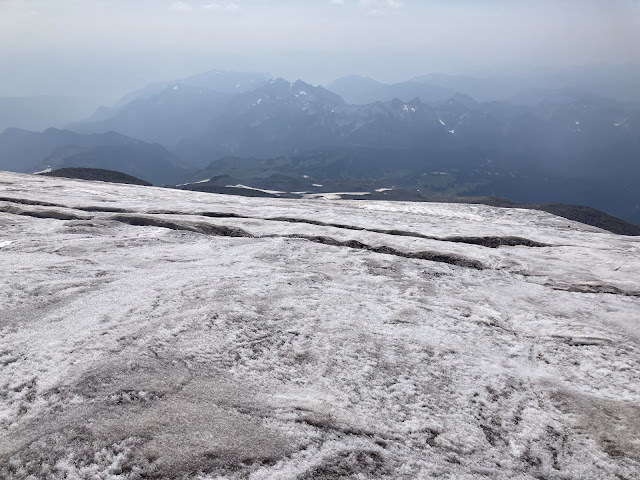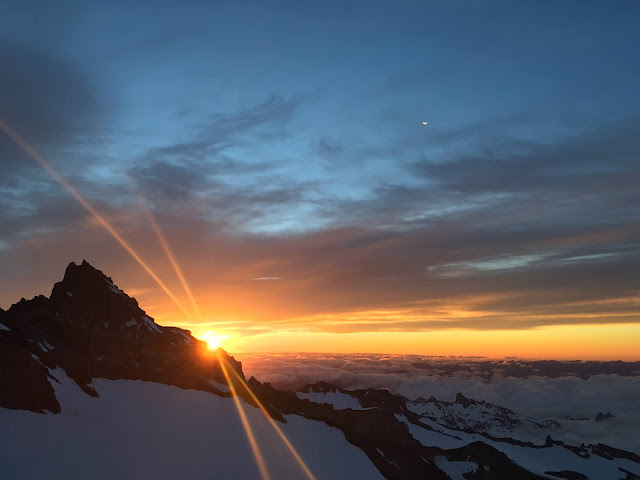 |
| Sunrise from the Disappointment Cleaver. Always a sight to behold. |
DC Conditions ReportRangers, guided parties, and independent climbers have been summiting the Disappointment Cleaver regularly via what is being called a "fast route". While not as straight up the mountain as the route was in early July, the current route is relatively straightforward and in good shape. Rangers climbed the route on 7/14 and noted these conditions.
Camp Muir
Crevasses are starting to open up in the main camping area, so take a moment upon arrival to figure out where they are. They are sometimes hard to discern due to the numerous bootprints across them, however, they do pose a hazard to unsuspecting climbers.
Camp Muir to Ingraham Flats:
Leaving Camp Muir and crossing the Cowlitz Glacier follows a standard path. While trending east towards the rocks of Cathedral Gap there is an encroaching crack that is likely to push the boot pack higher on the Cowlitz. The late season crevasse that normally forms in a line around 10,400 and angles from the Cathedral Gap trail toward the Beehive is beginning to sag and show signs of opening soon. Rangers noted active rockfall all around the upper Cowlitz Glacier and across the last portion of the glacier before gaining the rock trail on Cathedral Gap. Further, while trending down the scree onto the Ingraham Glacier, the trail takes a low path onto an icy, watery, gravely mix of firma before getting onto the snowy bootpack. Keep your headlight on a swivel through this section as well due to significant rockfall hazard from above.
 |
| Camping areas and route on the Cowlitz Glacier as seen from the helipad, Camp Muir (7/10) |
Ingraham Flats to Disappointment Cleaver:
Once onto the Ingraham Glacier, the route follows a typical path heading up fall line towards the icy seracs of the Ingraham. Rangers found it appropriate to take a quick break around 11,200' to adjust before entering the objectively risky traverse from high crack to the cleaver. As the route reaches its high point on the Ingraham Glacier an icy snow bridge allows climbers to cross "high crack" and begin their traverse to the trail up the cleaver. Solid footwork and focus here are key. Having your team ready to arrest a fall or to belay across this could be a good choice for your group. On the high side of the crossing there is an anchor point that can be used as a running belay on the way down and it is advisable to take advantage of during the descent. The traverse to the rocks follows the usual route and, as always, is subject to ice and then rock fall. There have been reports of teams stopping to take breaks in this zone on the way down recently and we want to remind climbers this is an area to be efficient, if not quick, to move through as the objective risk is high here - especially as as the day progresses.
 |
| The upper Ingraham Glacier traverse from high crack to the cleaver. |
The Disappointment Cleaver
The path of least resistance up the cleaver takes you to the "Nose". High on the Nose you will traverse climbers-left to a couple portions of deep boot pack through the snow and back onto the rocks toward the top. As always, heightened awareness under headlamp will keep you on route, on the best rock, and ease the travel for this portion of the route (its never harder than third class scrambling). Staying on route here diminishes the chances of creating rockfall caused by climbers inadvertently on the more exposed terrain or off-route. Rangers have noticed some parties remained spaced out on their rope teams through the cleaver, and we want to remind climbers to shorten your spacing through the rocky portions of the DC route to minimize the chance of your rope creating rockfall or getting damaged.
Top of the Cleaver to the Summit
Above the cleaver, the route follows an angling left, then trending middle right line winding between areas of serac and crevasse-complexity. The number of switchbacks have increased since our last DC blog update, but the route does not take any circuitous jogs to end-run cracks as of this post. Around 13,100' a large crevasse is crossed using a fixed ladder section set at approximately a 70 degree angle. There are ropes on both sides which can be used as handlines to increase security. The boot pack on the upper mountain is becoming a deep and narrow trench in some sections. Rangers found it helpful to step out of the trench at times to ease travel and avoid snagging a crampon.
 |
| Alpenglow on the upper mountain. From the top of the cleaver 7/14. |
 |
| 13,100' Ladder crossing. |
Descent
As a reminder, the heat dome of early July produced unprecedented effects on the mountain. While the route is getting climbed regularly, teams have been starting early to increase their safety on the descent. Snow bridges failing, crevasses opening, ice and rockfall are all standard hazards encountered on the DC route. With freezing levels above the summit for weeks now (following record high temps), these hazards only increase with exposure to the heat of the day. Have fun out there, Start early and Climb On!



















































